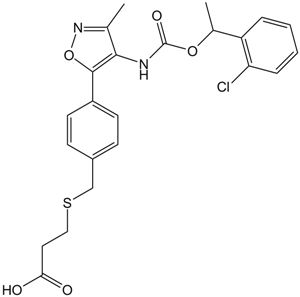Ki16425 (Synonyms: Debio 0719) |
| Catalog No.GC11374 |
LPA receptor antagonist
Products are for research use only. Not for human use. We do not sell to patients.

Cas No.: 355025-24-0
Sample solution is provided at 25 µL, 10mM.
Ki16425 is a subtype-selective antagonist of lysophosphatidic acid receptor (LPA) with Ki values of 0.34 μM for LPA1, 6.5μM for LPA2, and 0.93μM for LPA3 [4].
It has been reported that Ki16425 inhibited the LPA receptor-mediated actions in the order of LPA1≥LPA3≥LPA2. Ki16425 inhibited LPA-induced guanosine 5’-O-(3-thio) triphosphate binding, membrane fractions binding, and was involved in the long-term responses, including DNA synthesis and cell migration [1]. Ki16425 attenuated LPA-mediated intracellular signaling and invasion responses in vitro. Co-treatment of Ki16425 and sunitinib prolonged the sensitivity of renal tumor cell to sunitinib in xenograft mouse models [3]. In human breast cancer cells, Ki16425 can inhibit heparin-binding EGF-like growth factor (HB-EGF) expression [4].
In mouse thoracic aorta, Ki16425 significantly reduced LPA-induced vasorelaxation [2]. Ki16425 treatment also blocked renal tumorigenesis in vivo [3]. A five-day treatment with Ki16425 significantly decreased both HB-EGF mRNA expression at the transplanted tumor site in mice and circulating human HB-EGF concentrations in serum [4].
References:
[1]. Ohta H, Sato K, Murata N, Damirin A, Malchinkhuu E, Kon J, Kimura T, Tobo M, Yamazaki Y, Watanabe T, Yagi M, Sato M, Suzuki R, Murooka H, Sakai T, Nishitoba T, Im DS, Nochi H, Tamoto K, Tomura H, Okajima F. Ki16425, a subtype-selective antagonist for EDG-family lysophosphatidic acid receptors. Mol Pharmacol. 2003 Oct;64(4):994-1005.
[2]. Ruisanchez É, Dancs P, Kerék M, Németh T, Faragó B, Balogh A, Patil R, Jennings BL, Liliom K, Malik KU, Smrcka AV, Tigyi G, Benyó Z. Lysophosphatidic acid induces vasodilation mediated by LPA1 receptors, phospholipase C, and endothelial nitric oxide synthase. FASEB J. 2014 Feb;28(2):880-90.
[3]. Su SC, Hu X, Kenney PA, Merrill MM, Babaian KN, Zhang XY, Maity T, Yang SF, Lin X, Wood CG. Autotaxin-lysophosphatidic acid signaling axis mediates tumorigenesis and development of acquired resistance to sunitinib in renal cell carcinoma. Clin Cancer Res. 2013 Dec 1;19(23):6461-72.
[4]. David M, Sahay D, Mege F, Descotes F, Leblanc R, Ribeiro J, Clézardin P, Peyruchaud O. Identification of Heparin-Binding EGF-Like Growth Factor (HB-EGF) as a Biomarker for Lysophosphatidic Acid Receptor Type 1 (LPA1) Activation in Human Breast and Prostate Cancers. PLoS One. 2014 May 14;9(5):e97771.
Average Rating: 5 (Based on Reviews and 33 reference(s) in Google Scholar.)
GLPBIO products are for RESEARCH USE ONLY. Please make sure your review or question is research based.
Required fields are marked with *




















